
High Performance Oscilloscopes
- |
- Automotive
- |
- Data Acquisition
- |
- Electrical
- |
- Environmental
- |
- Food Safety
- |
- Mechanical Measurement
- |
- Multimeters
- |
- Test & Measurement
- |
- Temperature Monitoring
- |
- Test Accessories
- |
- Thermometers
- |
Flexible Resolution
Most digital oscilloscopes gain their high sampling rates by interleaving multiple 8-bit ADCs. Despite careful design, the interleaving process introduces errors that always make the dynamic performance worse than the performance of the individual ADC cores.
The PicoScope 5000 scopes have a significantly different architecture in which multiple high-resolution ADCs can be applied to the input channels in different series and parallel combinations to boost either the sampling rate or the resolution. In series mode, the ADCs are interleaved to provide 1 GS/s at 8 bits (see Fig1).
Interleaving reduces the performance of the ADCs, but the result (60 dB SFDR) is still much better than oscilloscopes that interleave 8-bit ADCs. This mode can also provide 500 MS/s at 12 bits resolution.
In parallel mode, multiple ADCs are sampled in phase on each channel increasing the resolution to 14 bits (see Fig 1) at 125 MS/s per channel (70 dB SFDR). If only two channels are required then resolution can be increased to 15 bits, and in single-channel mode all the ADCs are combined to give a 16‑bit mode at 62.5 MS/s.

Portability
Pico Technology oscilloscopes are small, light and portable. In 2-channel mode the 5000 Series scopes can be powered from USB only, making them ideal for the engineer on the move. The external power supply is only needed when operating more than 2 channels. The 5000 Series oscilloscopes are suitable for field use in many applications, such as design, research, test, education, service and repair.
High Bandwidth, High Sampling Rate
Most USB-powered oscilloscopes have real-time sampling rates of only 100 or 200 MS/s, but the PicoScope 5000 Series offers up to 1 GS/s, and a maximum bandwidth of 200 MHz. Equivalent time sampling (ETS) mode can be used to further boost the sampling rate to 10 GS/s for a more detailed view of repetitive signals.
Digital triggering
Most digital oscilloscopes sold today still use an analog trigger architecture based on comparators. This can cause time and amplitude errors that cannot always be calibrated out. The use of comparators often limits the trigger sensitivity at high bandwidths.
In 1991 we pioneered the use of fully digital triggering using the actual digitized data. This technique reduces trigger errors and allows our oscilloscopes to trigger on the smallest signals, even at the full bandwidth. Trigger levels and hysteresis can be set with high precision and resolution.
Digital triggering also reduces re-arm delay and this, combined with the segmented memory, allows the triggering and capture of events that happen in rapid sequence. At the fastest timebase you can use rapid triggering to collect 10,000 waveforms in under 20 milliseconds. Our mask limit testing function can then scan through these waveforms to highlight any failed waveforms for viewing in the waveform buffer.
Huge buffer memory
The PicoScope 5000 Series offers memory depths up to 512 million samples, more than any other oscilloscope in this price range. Other oscilloscopes have high maximum sampling rates, but without deep memory they cannot sustain these rates on long timebases. Using its 512 MS buffer, the PicoScope 5444B can sample at 1 GS/s all the way down to 50 ms/div (500 ms total capture time).

Managing all this data calls for some powerful tools. There's a set of zoom buttons, plus an overview window that lets you zoom and reposition the display by simply dragging with the mouse. Zoom factors of several million are possible.
Each captured waveform is stored in a segmented buffer so you can rewind and review up to 10,000 previous waveforms. No longer will you see a glitch on the screen only for it to vanish before you stop the scope. A mask can be applied to hide waveforms that are not of interest.
Advanced triggers
As well as the standard range of triggers found on most oscilloscopes, the PicoScope 5000 series has a full complement of advanced triggers as standard to help you capture the data you need.
Advanced triggers include:
Pulse Width:
Window:
Dropout:
Delay:
Logic Level:
Pulses less than/greater than a specified time width can be triggered on.
If a signal moves into or out of a specified window, defined by 2 thresholds, a trigger event can be generated. Optionally, the event can be qualified by pulse width, and other trigger sources.
Triggers after a signal stops toggling for a user defined amount of time, can be qualified by other trigger sources
Once a trigger event has been identified, the unit can be configured to trigger on the nth event and can additionally be delayed by a user defined amount of time.
A range of triggers to identify a user defined logic state or pattern. There are up to 4 logic trigger sources: CHA, CHB, EXT and AUX I/O.
Arbitrary waveform and function generator
All units have a built-in function generator (sine, square, triangle, DC level). As well as basic controls to set level, offset and frequency, more advanced controls allow you to sweep over a range of frequencies. Combined with the spectrum peak hold option this makes a powerful tool for testing amplifier and filter responses.
The PicoScope 5000 Series B models include additional built-in waveforms as well as an arbitrary waveform generator. Waveforms can be created or edited using the built-in AWG editor, imported from oscilloscope traces, or loaded from a spreadsheet.
High signal integrity
Most oscilloscopes are built down to a price; ours are built up to a specification. Careful front-end design and shielding reduces noise, crosstalk and harmonic distortion. Years of oscilloscope experience leads to improved pulse response and bandwidth flatness.
We are proud of the dynamic performance of our products and publish these specifications in detail. The result is simple: when you probe a circuit, you can trust in the waveform you see on the screen.
Picoscope Features
High-end features as standard
Buying a scope from some companies is a bit like buying a car. By the time you have added all the optional extras you need, the price has gone up considerably. With the PicoScope 5000 Series, high‑end features such as mask limit testing, serial decoding, advanced triggering, measurements, math, XY mode, digital filtering and segmented memory are all included in the price.
To protect your investment, both the PC software and firmware inside the unit can be updated. We have a long history of providing new features for free as software downloads. Other companies make vague promises about future enhancements but we deliver on our promises year after year. Users of our products reward us by becoming lifelong customers, frequently recommending us to their colleagues.
The design of the PicoScope software ensures that maximum display area is available for waveform viewing. Even with a laptop you have a much bigger viewing area and higher resolution than a typical benchtop scope.
Persistence display modes
See old and new data superimposed, with new data in a brighter color or shade. This makes it easy to see glitches and dropouts and to estimate their relative frequency. Choose between analog persistence and digital color, or create a custom display mode.
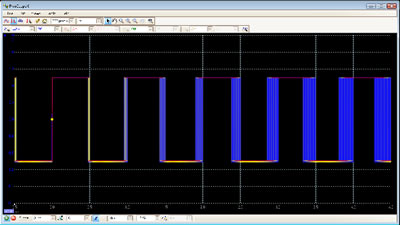
Serial decoding
The PicoScope 5000 Series, with its deep memory, is ideal for serial decoding as it can capture thousands of frames of uninterrupted data. Protocols currently included are I²C, SPI, RS232/UART, CAN, LIN and FlexRay. Expect this list to grow with free software updates.
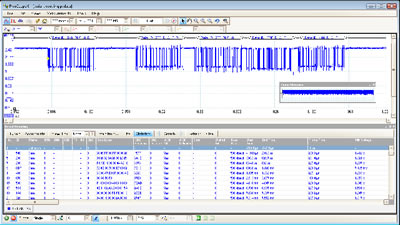
High-Speed Data Acquisition/Digitizer
The drivers and software development kit supplied allow you to write your own software or interface to popular third-party software packages such as LabVIEW.
If the scope's ultra-deep memory isn't enough, the driver supports data streaming, a mode that captures gap-free continuous data through the USB port directly to the PC's RAM or hard disk at a rate of over 10 MS/s (maximum speed is PC-dependent).
Mask limit testing
This feature is specially designed for production and debugging environments. Capture a signal from a known working system, and PicoScope will draw a mask around it with your specified tolerance.
Connect the system under test, and PicoScope will highlight any parts of the waveform that fall outside the mask area. The highlighted details persist on the display, allowing the scope to catch intermittent glitches while you work on something else. The measurements window counts the number of failures, and can display other measurements and statistics at the same time. You can import and export masks as files.
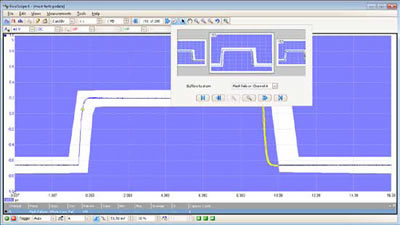
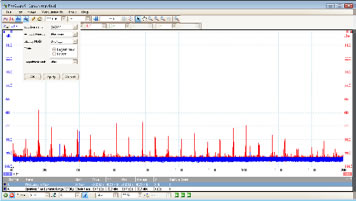
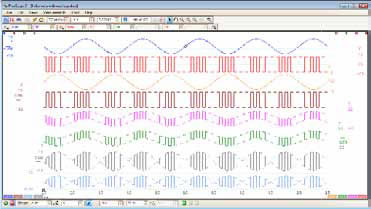
Spectrum Analyser
With a click of a button, you can display a spectrum plot of the selected channels with a maximum frequency up to 200 MHz. A full range of settings gives you control over the number of spectrum bands, window types and display modes: instantaneous, average, or peak-hold.
You can display multiple spectrum views with different channel selections and zoom factors, and see these alongside time-domain waveforms of the same data. A comprehensive set of automatic frequency-domain measurements, including THD, THD+N, SNR, SINAD and IMD, can be added to the display.
You can display multiple spectrum views with different channel selections and zoom factors, and see these alongside time-domain waveforms of the same data. A comprehensive set of automatic frequency-domain measurements, including THD, THD+N, SNR, SINAD and IMD, can be added to the display.
Math channels
Create new channels by combining input channels and reference waveforms. Choose from a wide range of arithmetic, logarithmic, trigonometric and other functions. Define a function using the push-button control panel or type an equation in the text box.
Custom Probe Settings
The custom probes feature allows you to correct for gain, attenuation, offsets and nonlinearities in special probes, or to convert to different units of measurement (such as current, power or temperature).
You can save definitions to disk for later use.
Connections
The front panels of the 2-channel PicoScope 5000 Series oscilloscopes have:
- 2 x BNC analog input channels
- 1 x BNC external trigger input
- 1 x BNC AWG/function generator output
- 1 x probe compensation output
The front panels of the 4-channel PicoScope 5000 Series oscilloscopes have:
- 4 x BNC analog input channels
- 1 x BNC external trigger input
- 1 x BNC AWG/function generator output
- 1 x probe compensation output
The rear panels of all oscilloscopes in the PicoScope 5000 Series have:
- 1 x DC power socket
- 1 x USB 2.0 port
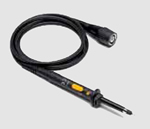
Probes
Your PicoScope 5000 Series oscilloscope kit comes with 2 or 4 10:1/1:1 switchable oscilloscope probes specifically trimmed to match the performance of your oscilloscope.
| 60 MHz | 150 MHz | 250 MHz |
| MI007 | TA132 | TA131 |
Kit Contents & Accessories
Your PicoScope 5000 Series oscilloscope kit contains the following items:
- PicoScope 5000 Series oscilloscope
- 2 x 10:1/1:1 probes (2-channel scopes)
- 4 x 10:1/1:1 probes (4-channel scopes)
- Double-headed USB 2.0 cable
- Standard USB 2.0 cable (4-channel scopes only)
- Mains power adaptor (4-channel scopes only)
- Quick Start Guide
- Software and Reference CD
Tools > Reference channels: Store waveforms in memory or on disk and display them alongside live inputs. Ideal for diagnostics and production testing.
Tools > Masks: Automatically generate a test mask from a waveform or draw one by hand. PicoScope highlights any parts of the waveform that fall outside the mask and shows error statistics.
Spectrum view: View FFT data alongside scope view or independently.
| Vertical | 5242A | 5442A | 5242B | 5442B | 5243A | 5443A | 5243B | 5443B | 5244A | 5444A | 5244B | 5444B |
|---|---|---|---|---|---|---|---|---|---|---|---|---|
| Number of Channels | 2 | 4 | 2 | 4 | 2 | 4 | 2 | 4 | 2 | 4 | 2 | 4 |
| Bandwidth (-3 dB) | All modes: 60 MHz | 8 to 15-bit modes: 100 MHz •16-bit mode: 60 MHz |
8 to 15-bit modes: 200 MHz •16-bit mode: 60 MHz |
|||||||||
| Bandwidth Limiting (–3 dB) | 20 MHz, switchable | |||||||||||
| Rise time (Calculated, 10%~90%) |
All modes: 5.8 ns | 8 to 15-bit modes: 3.5 ns •16-bit mode: 5.8 ns | 8 to 15-bit modes: 1.8 ns •16-bit mode: 5.8 ns | |||||||||
| Input Connectors | BNCs on front panel | |||||||||||
| Resolution* Enhanced Vertical Resolution | 8 bits, 12 bits, 14 bits, 15 bits, 16 bits Hardware resolution + 4 bits |
|||||||||||
| Input Characteristics | 1 MΩ ±1% || 13 pF, ±1 pF | |||||||||||
| Input Coupling | AC/DC | |||||||||||
| Input Sensitivity | 2 mV/div to 4 V/div | |||||||||||
| Input Ranges | ±10 mV to ±20 V full scale, in 11 ranges | |||||||||||
| Analog Offset Range | ±250mV (10, 20, 50, 100, 200 mV ranges), ±2.5 V (500 mV, 1 V, 2 V ranges), ±20 V (5, 10, 20 V ranges) | |||||||||||
| DC Accuracy ±50 mV to ±20 V ±10 mV & ±20 mV Ranges |
≥ 12-bit mode: ±0.25% typical @ 25°C (±1% of full scale max @ 20 - 30°C) •8-bit mode: ±1% typical @ 25°C (±3% of full scale max @ 20 - 30°C) All modes: ±2% typical @ 25°C (±5% of full scale max @ 20 - 30°C) |
|||||||||||
| Overvoltage Protection | ± 100 V (DC + AC peak) | |||||||||||
| Horizontal | All Models | ||||||||||||||||||||||||||||||||||||
|---|---|---|---|---|---|---|---|---|---|---|---|---|---|---|---|---|---|---|---|---|---|---|---|---|---|---|---|---|---|---|---|---|---|---|---|---|---|
| Max. Sampling Rate |
|
||||||||||||||||||||||||||||||||||||
| Any 1 Channel | |||||||||||||||||||||||||||||||||||||
| Any 2 Channels | |||||||||||||||||||||||||||||||||||||
| Any 3 Channels | |||||||||||||||||||||||||||||||||||||
| Four channels | |||||||||||||||||||||||||||||||||||||
| 5242A | 5442A | 5242B | 5442B | 5243A | 5443A | 5243B | 5443B | 5244A | 5444A | 5244B | 5444B | ||||||||||||||||||||||||||
| Sampling Rate (Repetitive Sampling) | 2.5 GS/s | 5 GS/s | 10 GS/s | ||||||||||||||||||||||||||||||||||
| Sampling Rate (USB Streaming) | 10 MS/s in PicoScope 6. >10 MS/s using supplied API | ||||||||||||||||||||||||||||||||||||
| Timebase Ranges | 2 ns/div to 1000 s/div | 1 ns/div to 1000 s/div | 500 ps/div to 1000 s/div | ||||||||||||||||||||||||||||||||||
| Buffer Memory** (8-bit) | 16 MS | 32 MS | 64 MS | 128 MS | 256 MS | 512 MS | |||||||||||||||||||||||||||||||
| Buffer Memory** (≥ 12-bit) | 8 MS | 16 MS | 32 MS | 64 MS | 128 MS | 256 MS | |||||||||||||||||||||||||||||||
| Buffer Memory** Continuous Streaming | 100 MS in PicoScope software | ||||||||||||||||||||||||||||||||||||
| Waveform buffer (No. of Segments) |
10,000 in PicoScope software | ||||||||||||||||||||||||||||||||||||
| Timebase Accuracy (Drift) | ±50 ppm (±5 ppm/year) | ±2 ppm (±1 ppm/year) | ±2 ppm (±1 ppm/year) | ||||||||||||||||||||||||||||||||||
| Sample Jitter | 3 ps RMS, typical | ||||||||||||||||||||||||||||||||||||
| Dynamic Performance (Typical; Analog Channels) | ||||||||||||
|---|---|---|---|---|---|---|---|---|---|---|---|---|
| Crosstalk | Better than 400:1 up to full bandwidth (equal voltage ranges) | |||||||||||
| Total Harmonic Distortion (THD) | 8-bit mode: > 60 dB at 100 kHz full scale input •≥ 12-bit mode:> 70 dB at 100 kHz full scale input | |||||||||||
| SFDR | 8 and 12-bit: > 60 dB at 100 kHz full scale input •14 to 16-bit: > 70 dB at 100 kHz full scale input | |||||||||||
| Noise (On 50 mV Range) | 8-bit mode 120 μV RMS •12-bit mode 110 μV RMS •14-bit mode 100 μV RMS •15-bit mode 85 μV RMS •16-bit mode 70 μV RMS | |||||||||||
| Bandwidth Flatness | (+0.3 dB, -3 dB) from DC to full bandwidth | |||||||||||
| Triggering | |
|---|---|
| Source | All Channels |
| Trigger Modes | None, Auto, Repeat, Single, Rapid (segmented memory) |
| Advanced Triggers | Edge, Window, Pulse width, Window pulse width, Dropout, Window dropout, Interval, Runt pulse, Logic |
| Trigger Types (ETS mode) | Rising, falling |
| Sensitivity | Digital triggering provides 1 LSB accuracy up to full bandwidth of scope. • ETS mode: Typical 10 mV p-p, at full bandwidth |
| Maximum Pre-Trigger Capture | 100% of capture size |
| Maximum Post-Trigger Capture | 4 billion samples |
| Maximum Trigger Rate | Up to 10,000 waveforms in a 20 ms burst |
| External Trigger Input | |||
|---|---|---|---|
| Trigger Types | Edge, pulse width, dropout, interval, logic | ||
| Input Characteristics | Front panel BNC, 1 MΩ ±1% || 13 pF ±1 pF | ||
| Bandwidth | 60 MHz | 100 MHz | 200 MHz |
| Voltage Range | ±5 V, DC coupled | ||
| Overvoltage Protection | ±100 V (DC + AC peak) | ||
| Function Generator | |||
|---|---|---|---|
| Standard Output Signals | Sine, square, triangle, DC voltage | ||
| Standard Signal Frequency | DC to 20 MHz | ||
| Output Frequency Accuracy | ±50 ppm (±5 ppm/year) | ±2 ppm (±1 ppm/year) | ±2 ppm (±1 ppm/year) |
| Output Frequency Resolution | < 50 mHz | ||
| Output Voltage Range | ±2 V with ±1% DC accuracy | ||
| Output Voltage Adjustment | Signal amplitude and offset adjustable in approx. 0.25 mV steps within overall ± 2 V range | ||
| Amplitude Flatness | < 2 dB to 20 MHz, typical @ 50 Ω load | ||
| SDFR | > 70 dB, 10 kHz full scale sine wave | ||
| Connector Type | BNC, 50 Ω output impedance | ||
| Overvoltage Protection | ±20 V | ||
| Sweep Modes | Up, down, or alternating, with selectable start/stop frequencies and increments | ||
| AWG (B models only) | ||||||
|---|---|---|---|---|---|---|
| Update Rate | - | 200 MS/s | - | 200 MS/s | - | 200 MS/s |
| Buffer size | - | 16 kS | - | 32 kS | - | 48 kS |
| Resolution | - | 14 bits (output step size approx. 0.25 mV) | - | 14 bits (output step size approx. 0.25 mV) | - | 14 bits (output step size approx. 0.25 mV) |
| Bandwidth | - | > 20 MHz | - | > 20 MHz | - | > 20 MHz |
| Rise Time (10% to 90%) | - | < 10 ns | - | < 10 ns | - | < 10 ns |
| Probe Compensation Output | |
|---|---|
| Output Characteristics | 600 Ω |
| Output Frequency | 1 kHz |
| Output Level | 3 V pk-pk |
| Overvoltage Protection | 10 V |
| Spectrum Analyser | |||
|---|---|---|---|
| Frequency Range | DC to 60 MHz | DC to 100 MHz | DC to 200 MHz |
| Display Modes | Magnitude, average, peak hold | ||
| Windowing Functions | Rectangular, Gaussian, triangular, Blackman, Blackman-Harris, Hamming, Hann, flat-top | ||
| Number of FFT points | Selectable from 128 to 1 million in powers of 2 | ||
| Math Channels | |
|---|---|
| Functions | –x, x+y, x–y, x*y, x/y, x^y, sqrt, exp, ln, log, abs, norm, sign, sin, cos, tan, arcsin, arccos, arctan, sinh, cosh, tanh, delay |
| Operands | A, B, C, D (input channels), T (time), reference waveforms, pi |
| Automatic Measurements | |
|---|---|
| Oscilloscope | AC RMS, true RMS, DC average, cycle time, frequency, duty cycle, falling rate, fall time, rising rate, rise time, high pulse width, low pulse width, maximum, minimum, peak to peak |
| Spectrum | Frequency at peak, amplitude at peak, average amplitude at peak, total power, THD %, THD dB, THD+N, SFDR, SINAD, SNR, IMD |
| Statistics | Minimum, maximum, average and standard deviation |
| Serial Decoding | |
|---|---|
| Protocols | I²C, I²S, SPI, RS232/UART, CAN, LIN, FlexRay |
| Mask Limit Testing | |
|---|---|
| Statistics | Pass/fail, failure count, total count |
| Display | |
|---|---|
| Interpolation | Linear or sin(x)/x |
| Persistence Modes | Digital color, analog intensity, custom, or none |
| General | |
|---|---|
| PC Connectivity | USB 2.0 hi-speed (USB 1.1 and USB 3.0 compatible) |
| Power Requirements | 1 A (2 channels) from 2 USB ports (double-headed cable supplied) or 1.5 A at 5 V (up to 4 channels) from AC adaptor |
| Dimensions | 190 x 170 x 40 mm (including connectors), < 0.5 kg |
| Temperature Range | Operating: 0 °C to 50 °C (20 °C to 30 °C for stated accuracy). Storage: –20 °C to 60 °C. |
| Humidity Range | Operating: 5 %RH to 80 %RH non-condensing. Storage: 5 %RH to 95 %RH non-condensing. |
| Environment | Dry locations only; up to 2000 m altitude |
| Safety Approvals | Designed to EN 61010-1:2010 |
| EMC Approvals | Tested to EN61326-1:2006 and FCC Part 15 Subpart B |
| Environmental Approvals | RoHS and WEEE compliant |
| Software/ PC Requirements |
PicoScope 6, SDK and example programs. Microsoft Windows XP, Windows Vista, Windows 7 or Windows 8 (Windows RT not supported) |
| Accessories Included | |
|---|---|
| Additional Hardware | USB cable(s), 2 or 4 10:1/1:1 switchable probes in probe case, AC adaptor for 4-channel scope |
| Top of Page | *15% GST applicable for sales within NZ | |
| Legal and Where to Buy | ||
| Sitemap | ||